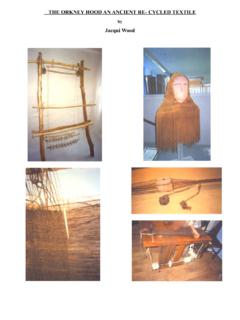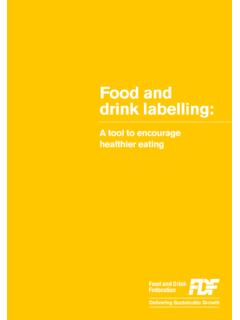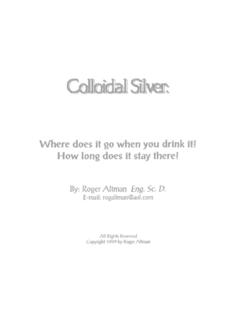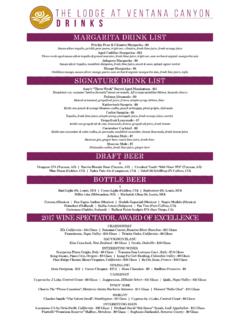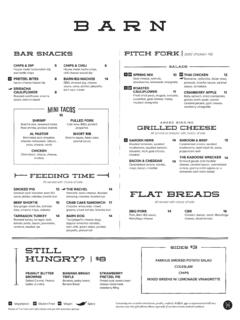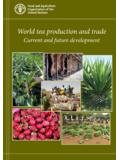Transcription of FOOD AND DRINK IN EUROPEAN PREHISTORY
1 FOOD AND DRINK IN EUROPEAN PREHISTORYA bstract: There is a wealth of archaeological evidence, from bones excavated inprehistoric middens, piles of fruit stones and sea shells, that give us concreteindications of food consumed at various prehistoric sites around Europe. Added to thisinformation we have pollen analysis from settlement sites and charred plantmacrofossils. Wetland archaeology informs us in much more detail not just whichfoods our prehistoric forbears were eating, but also their cooking techniques in somecases. This paper will explore whether or not a popular misconception about the dailydiet in PREHISTORY has its roots in the analysis of stomachs contents of various bogbodies found in : ethnology, cooking techniques, salt production, bog bodies, fogou's,prehistoric interpret cooking in Ancient times is not as difficult as one might imagine. Thereare various quotations by the Classical Historians, that lead us to believe that foodtastes, and traditions were as varied in Ancient Europe, as they are today.
2 If onevisited an Iberian Celtic Chief, one might expect to be served a chunk of bread, and thebest cut of some spit roasted meat, so the Greek Historian Diodorus Siculus 50 BCtells us (Siculus Vol. 5, Chapter 11 :212 ). However, if one were to visit AncientCyprus at the time of Herodotus 450 BC, you might have been served a dishcontaining fish cakes made of minced sun dried fish (Herodotus Vol. 1: 200). There isalso a wealth of Archaeological evidence, such as the bones of animals found inancient middens, or piles of discarded fruit stones, or sea shells (Andersen 1985: 54).We can study pollen analysis from ancient sites, and charred plant macrofossils(Straker 1991 : 161). Also, evidence from the stomach contents of various wellpreserved bog bodies, give us an insight into their last meal ( Turner and Scaife 1995 :81). So the pieces of the puzzle are there. Yet, it is important as I said earlier to takeaccount of regional tastes.
3 Just as a person undertaking a, survey of EUROPEAN foodmight do would like to begin this paper with a quotation from Herodotus (Herodotus Vol. 2book 4: 61) about the Sythian people: Now the Sythian land is wondrous bare of wood: so this is their device for thecooking of flesh. When they have flayed the victims, they strip the flesh from thebones and throw it into the cauldrons of the country, if they have such: into these theycast all the flesh, and cook by lighting a fire beneath with the bones of the victims. Butif they have no cauldron, then they cast all the flesh into the victims stomachs, addingwater thereto, and make a fire beneath with the bones which burn finely: Thus the Oxserves to cook itself, and every other victim likewise.'2 Ethnographic studies of primitive cultures today teach us that, adaptation to theenvironment one lives in, is essential to survival. Therefore, if there is no wood to cookwith, then simply use the bones of your prey for fuel.
4 If there is no cooking pot, thenuse the animal s stomach. There is an example of this self-sufficient practice in thelives of the Siriono tribe of Bolivia today (Holuberg 1997: 159).'Little care is taken in dressing game, which is done either by men or women. Animalswith hair, such as monkeys and peccaries, are first singed whole in the fire, and theburned hair is then scraped off with the fingernails or with a small section of a midribof a motacu palm leaf. The animal is then gutted with a sharp piece of bamboo, afterwhich the whole carcass is sometimes (but by no means always) perfunctorily washedbefore it is cooked. Birds are hastily plucked and then singed in the fire and gutted. Ifan animal is small it is usually cooked whole, but if it is too large for a pot (or too largeto roast rapidly) it is quartered or cut up into smaller pieces with a bamboo animals like the armadillo and tortoise are usually thrown in the fire and leftthere to roast in their shells.
5 'In much the same way as the Sythian people in Herodotus's time used the naturalresources available to them to prepare and cook their quarry, this insight into thepractices of the Siriono people today are I feel comparable. Minimum of effort beingthe pivot around which the hunter-gatherer culture past and present function. The needto travel light on a hunting expedition would have been fundamental, as the carcass ofthe quarry would have to be carried home to camp. Therefore a makeshift cooking potor utensil would have been needed to cook meals while travelling away from camp onhunting TECHNIQUESC ooking techniques in ancient times must also have varied quite considerablythroughout Europe. In Ireland, Britain and Sweden there is evidence for a type ofcooking method using heated stones and water pit. In Ireland these sites are calledFilachta Fiadh (O Drisceoil 1990:157) where more than 4,000 sites of this type havebeen identified.
6 They appear as mounds of fire cracked stones usually in a crescent or ahorseshoe shape. In the centre of this horseshoe is a typical watertight through or pitwhen excavated, in which the heated stones were dropped into during use. There is areference to this practice in 'History of Ireland'. (Keating 1908:326 ).'it was their custom to send their attendants about noon with whatever they had killedin the mornings hunt to an appointed hill, to kindle raging fires thereon, and put inthem a large number of stones; and to dig two pits in the yellow clay of the moorland,3and put some meat on spits to roast before the fire: and then to bind another portion ofit with grasses in bundles. And set it to boil in the larger of the two pits, and keepplying with stones that were in the fire, making them seethe often until they werecooked. And these fires were so large that their sites are seen today in Ireland burnt toblackness and these sites are called filacht fian by the peasantry meaning cookingplaces'Athenaus quoting Posidonius also mentions the Celts in Europe cooking meat in water(Tierney 1960: 247) 'Their food consists of a few loaves of bread, but large quantitiesof meat prepared in water or roasted over coals on spits.
7 ' This account mirrors the Irishone very well I feel. Last year at Biskupin in Poland (a substantial Iron Age lakedwelling reconstruction), I was demonstrating this particular technique amongstothers, to the general public there. It is a very effective method of cooking any joint ofmeat. The basic principles for cooking meat in this way are the dropping of red-hotstones into a water filled, wood lined trough. There has been some research by VictorBuckley ( Buckley 1990: 170) into the most effective types of stones to use and re-heatin the fire.'A number of tentative conclusions can be drawn from the combinedevidence gleaned from the experimental testing of shatter variation in different rock'sand the random analysis of samples from two sites in different geological , drift-derived material was most commonly used and, though the type of driftmaterial was different, sedimentary rocks were preferred. Secondly, igneous and somemetamorphosed rocks are very reusable and may present a problem for archaeologists,particularly in northern areas, who may find a different morphology for fulachta fladhowing to this lithic longevity.
8 'Although burnt mounds are widespread in Ireland it is interesting to observe theabsence of fulachta fladh in Counties Galway, Limerick and Clare. This is probablydue to the limestone strata as Prof. O'Kelly observed in his paper (O Kelly 1954: 144).Limestone on contact with heat and water would turn to calcium hydroxide. Soalthough this is an efficient way to cook meat it probably did not merit the carrying ofstones long distances to cook with. Doubtless, only if rocks in the local geology weresuitable was this method of cooking used. The size of the meat joints that I used in myexperimentation at Biskupin averaged 5 kilos each. Each day we were plied with threesuch joints of Beef or Pork to cook, and on two occasions a whole Lamb was stones my team and I found in the locality were fine-grained granite, similar to theones that I had used previously in Cornwall. These stones were heated in a fierce firefor about one hour until they were red hot.
9 About a dozen were then dropped into thewater trough and the ensuing sizzle and whistling noise was quite deafening. It takesapproximately 15 minutes for red-hot stones to release most of their heat into thewater, consequently the water gradually came to the boil as a pan might4on a conventional cooker. The meat was wrapped in long fresh wayside grasses, in thefashion described by Keating in his description from Irish folklore. These grasses hadto be tied tightly with string, on this occasion spun nettle fibre. Linen string is a goodalternative but it tends to not have the elasticity of the nettle fibre, and on someoccasions goes slack in the water. Once the water was boiling, the grass wrapped meatwas ready to drop into the trough. Every so often over the course of two hours hotstones were added to the trough just to keep the water simmering. At the end of thistime the meat was taken out, and the grasses removed to reveal on each occasionconsistently well cooked meat.
10 All that was required was to crisp up the sides on somehot stones taken out of the fire, and it was ready to eat. This left the water filled troughfull of meat juices and fat from the meat, and it occurred to me that this could havebeen considered by our prehistoric forbears as too good to waste. So I undertook tosee what could be done with such fat rich water. The most logical and easiest solutionwas to mix a little bread dough, and drop it into the trough half way through the meatcooking. This dough dumpling takes on the flavour of the meat from its juices and the meat is taken out, the dough dumpling provides tasty bread to eat with dough required no extra effort or stones than was needed to cook the meat. I feelit would have been a logical utilisation of this finite heat source. In the seventeenthcentury herby dough dumplings cooked in cauldrons with boiling meat was commonpractice (Masson 1974: 120). This fat rich pudding would have been savoured I feel ifit had been made, especially as most of the flavour of meat is usually released from itsfat and juices during cooking.
